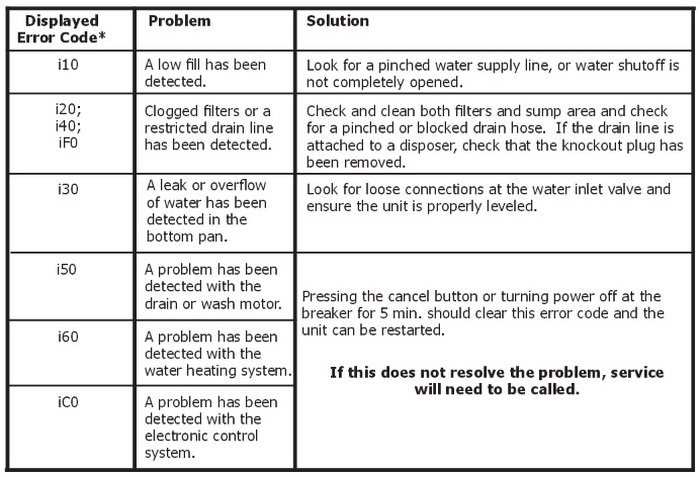
Here’s the deal: The E1 error is a sign that your dishwasher might be leaking, or it thinks it’s leaking. It’s a bit like when your phone says it’s low on battery—it’s a hint that something needs attention. Ignoring it might not spell disaster immediately, but it could lead to bigger issues down the line. Just like not charging your phone could leave you stranded without a map or music, not addressing a potential leak could lead to water damage or a broken appliance. Let’s dive deeper into understanding why this error pops up and what you can do about it.
Understanding the E1 Error Code
First off, the E1 error code isn’t some cryptic message trying to confuse you. Think of it as your dishwasher waving a little red flag. The “E1” code on Frigidaire dishwashers generally relates to a water-related problem. It’s like your dishwasher’s way of saying, “Hey, I might be leaking, or there’s a water level issue here!” Understanding this is the first step in deciding whether you can ignore it or need to take action.
Water leakage issues can come from places you might not think about. The door seal might not be holding tight, or the water supply line could be loose—kind of like a garden hose that isn’t fully connected, causing water to spray everywhere. Sometimes, it might even be a glitch in the system, but it’s best to rule out the serious possibilities first. Ignoring an E1 error might not cause immediate chaos, but it’s like ignoring the check engine light in your car—it’s there for a reason.
Now, let’s talk consequences. What can happen if you decide to ignore this error code? Well, continual ignorance might lead to issues with kitchen flooring, cabinetry, or even the dishwasher itself. Water leaks left unchecked could ruin your floorboards or cause mold—a silent but serious problem. The E1 code is your dishwasher’s way of saying, “Check me before things get worse.”
Potential Causes of the E1 Error Code
Imagine your dishwasher as a complex puzzle—each piece needs to fit just right for it to run smoothly. When it displays an E1 error, it’s like a piece of that puzzle isn’t where it should be. One common cause might be a faulty water inlet valve. The water inlet valve is akin to a gatekeeper, allowing the right amount of water into the dishwasher. If it malfunctions, it might let in too much water or none at all, causing the system to panic and flash the E1 code.
Another possible suspect could be the dishwasher’s float switch, which acts like a lifeguard keeping watch over the water level. If the float gets stuck, it might either falsely report a flood or fail to signal when the water level is too low. That’s like a lifeguard not alerting you to a strong tide—it spells trouble. Additionally, a worn-out door seal might let water escape, reminiscent of how a cracked dam leaks water.
These components might seem small, but they play crucial roles in keeping your dishwasher in tip-top shape. Checking these elements when you see an E1 error can prevent significant headaches later on. Think of it as doing a quick check-up on your car before a long road trip. It ensures everything’s in working order before bigger problems arise.
Steps to Address the E1 Error Code
So, what do you do next? Well, tackling the E1 error doesn’t require you to be a tech wizard. First, give the dishwasher a good once-over. Check that all the visible components, like the door seal and the inlet hose, are in good condition. Imagine giving your car tires a good kick to see if they’re flat—it’s the same principle here.
If everything seems okay, try resetting the dishwasher. Sometimes, electronic devices just need a little nudge, much like how rebooting a frozen computer brings it back to life. Unplug your dishwasher for a few minutes and then plug it back in. This can often reset the system, potentially solving the issue if it was just a glitch.
But what if the error persists? It might be time to call in a professional, someone who speaks fluent dishwasher. While DIY checks are great, a trained technician can perform a more thorough examination and pinpoint the exact problem. It’s like calling a mechanic when your car makes a funny noise you can’t diagnose yourself. They have the tools and expertise to ensure your dishwasher is back to its pristine condition.
Preventing Future E1 Errors
Now that you’ve navigated through the maze of the E1 error code, let’s talk prevention. Just like regular exercise keeps you healthy, a bit of routine maintenance can keep your dishwasher happy. One of the easiest things you can do is regularly inspect your dishwasher for any signs of wear and tear. Look for cracks in the door seal or any signs of damage to the water inlet valve.
Taking care to load your dishwasher correctly can also prevent problems. Overloading can put extra strain on the machine, much like carrying too many groceries at once can strain your arms. Follow the manufacturer’s guidelines on how to arrange your dishes to ensure everything gets cleaned and nothing gets damaged.
Lastly, consider running a cleaning cycle every now and then with dishwasher-safe cleaning solutions. It’s akin to giving your dishwasher a spa day, ensuring it runs smoothly and efficiently. With a little bit of regular TLC, you can prevent those pesky error codes from disrupting your dishwashing routine.
So, while you might be tempted to ignore the E1 error code, tackling it head-on is your best bet for a stress-free kitchen. By understanding what it means and taking the right actions, you can keep your dishwasher running smoothly and your kitchen floor nice and dry!